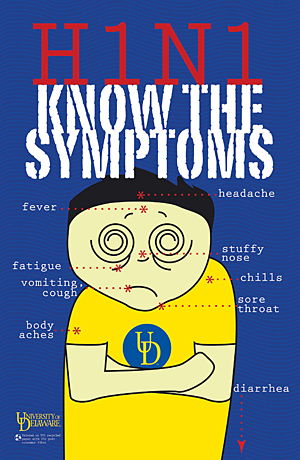- 5 things you need to know about H1N1 influenza
- Public Health offers H1N1 vaccine for high-risk groups
- Special dining policy established for ill students
- Custodial staff proactive against H1N1
- UD continues to educate the campus on H1N1 influenza
- State medical expert gives students latest information on H1N1 situation
- Center for Educational Effectiveness offers support in event of H1N1 outbreak
- Hand sanitizers available on four campuses
- Oct. 5: College of Health Sciences to present "Seasonal Flu vs. Swine Flu"
- Vaccinations for seasonal flu now available for UD students
- Letter to the faculty on H1N1 issues
- Personal protective supplies available through UD Mart
- IT recommends technology options for course continuity in event of H1N1 outbreak
- Information sessions on H1N1 scheduled in October
- Sept. 15 is Get Ready Day
- UD Library creates online 'H1N1 Information Guide'
- Tips for faculty on H1N1: Medical excuses
- UD prepares for H1N1
10:30 a.m., Aug. 28, 2009----Preparations for the 2009-10 academic year took on an added dimension this summer with the predictions by the Centers for Disease Control and Prevention that H1N1 Influenza (swine flu) will be widespread in the United States this fall.
Throughout the summer, UD's Communicable Disease Working Group has been assessing the situation, developing educational outreach programs, conducting emergency planning and discussing ways to keep the campus community safe.
"The campus community dealt well with the H1N1 outbreak last spring, and we're confident we can work together as a community to weather the next wave of the virus," Marcia Nickle, emergency preparedness coordinator and chairperson of the working group, said.
"Education about H1N1 and how it is transmitted are extremely important," she said. "Our top two messages this fall are 'wash your hands' and 'if you feel sick, stay home.'"
Posters highlighting H1N1 symptoms and ways to keep it from spreading have been distributed in campus residence halls. In addition, resident assistants have received special training that outlines preventative measures.
To help members of the campus community keep their hands clean, additional hand sanitizer stations have been added around the campus. There are now 37 stations across the University's four campuses. These touch-free, Purell dispensers are located at all eateries on the Newark campus and other large gathering areas such as the Bob Carpenter Center, the Carpenter Sports Building, the Perkins Student Center and the Trabant University Center.
In addition, emergency plans across the campus have been evaluated and updated to determine how the University would continue to provide its critical functions under different potential scenarios, such as canceling events or closing the University.
On Monday, Aug. 31, a new H1N1 411 Web page will be linked from the University's home page that will include the most current information about H1N1 preparation activities across the campus, as well as links to a variety of resources on the Web.
Later in the semester, question-and-answer sessions with representatives from the Delaware Department of Public Health will be presented. Plans are under way for a seasonal flu vaccine program this fall, and, if supplies of H1N1 vaccine are made available, an H1N1 vaccination program will be offered.
Actions you should take now
- Learn the symptoms of H1N1. According to the CDC, symptoms of H1N1 include fever or chills and cough or sore throat. Symptoms also can include runny nose, body aches, headache, tiredness, diarrhea or vomiting.
- Wash hands frequently with soap and water or use alcohol-based hand cleaners, especially after coughing or sneezing.
- Cover your mouth and nose with a tissue when you cough or sneeze. If you don't have a tissue, cough or sneeze into your elbow or shoulder, not into your hands.
- Avoid touching your eyes, nose or mouth. Germs spread this way.
- Make sure your contact information in the UD Alert System is correct and up to date. Any major announcements will be made through UD Alert and on the University's home page. Information on how to update contact information, which may be done online at any time, is available at these two Web sites for students and for staff.
If you get sick
Those who think they are sick with the flu should stay home or in their place of residence for at least 24 hours after there is no longer a fever. Staying away from others while sick will prevent others from getting sick. Drink plenty of clear fluids to keep from becoming dehydrated.
Students at high risk for complications from flu should contact their personal physicians or the Student Health Service. Other members of the University community should contact their personal physicians.
For more information, visit the U.S. government's Web site Flu.gov.
Posters designed by Molly Chappell




